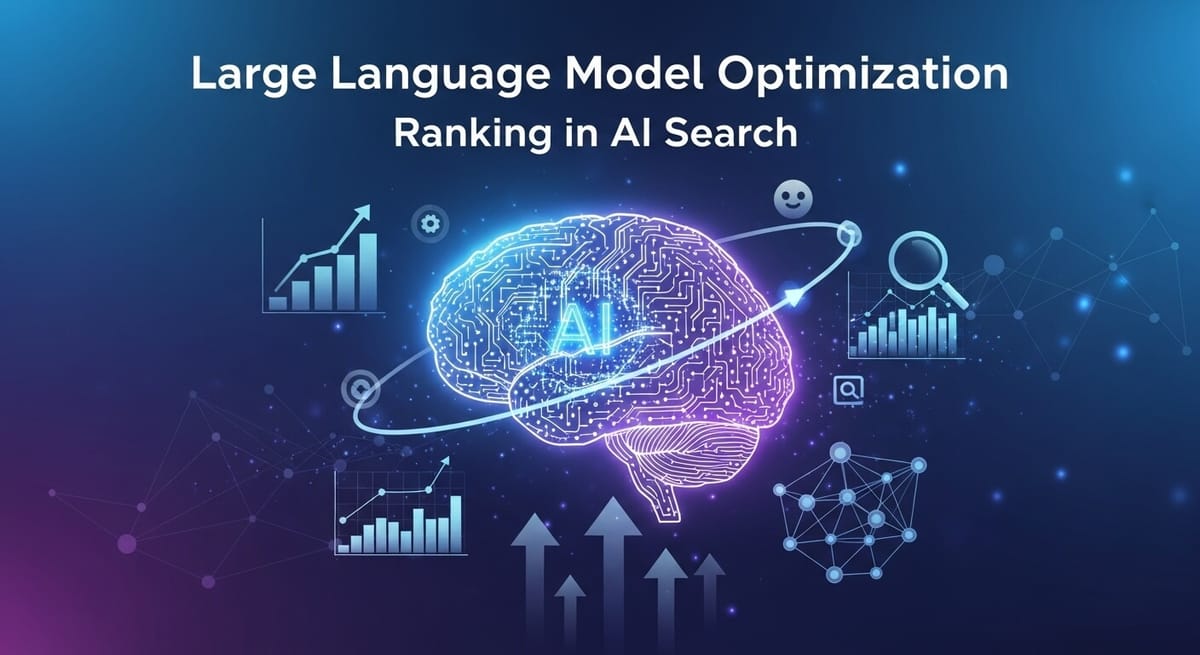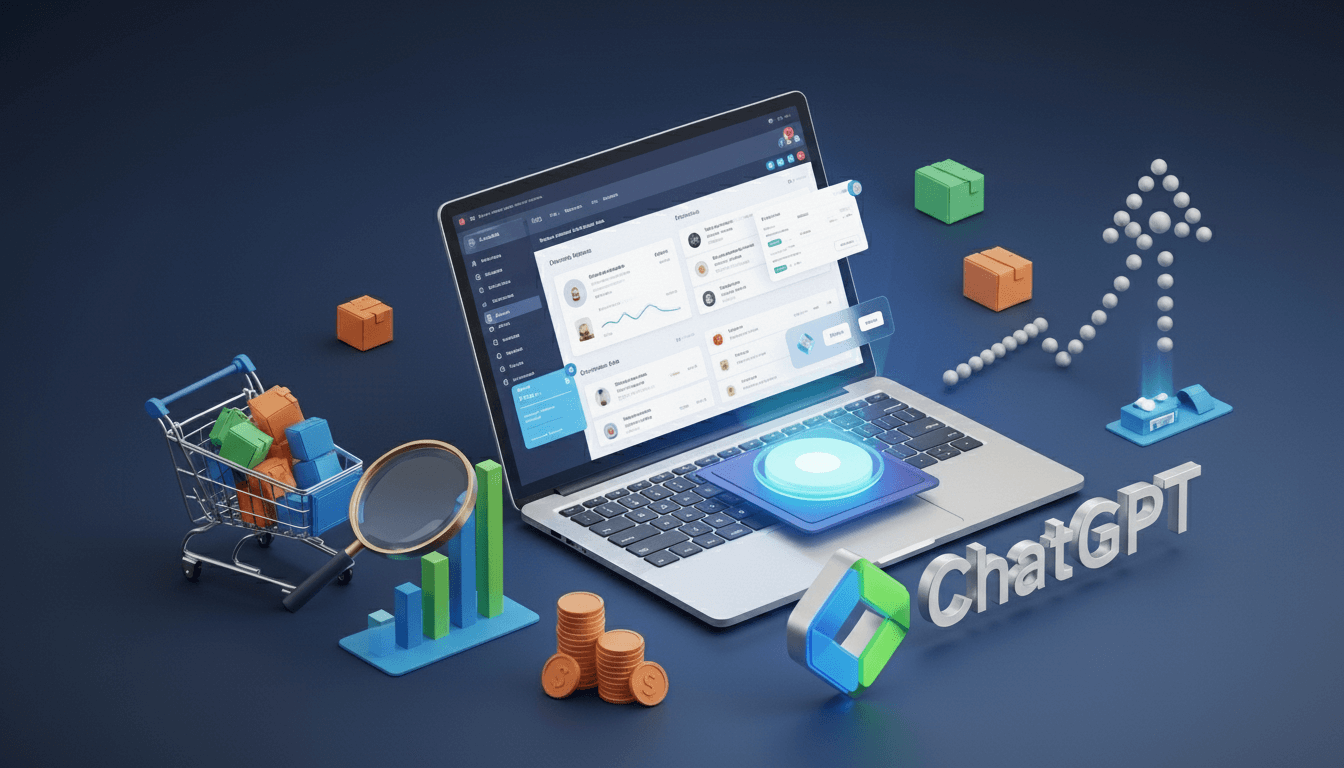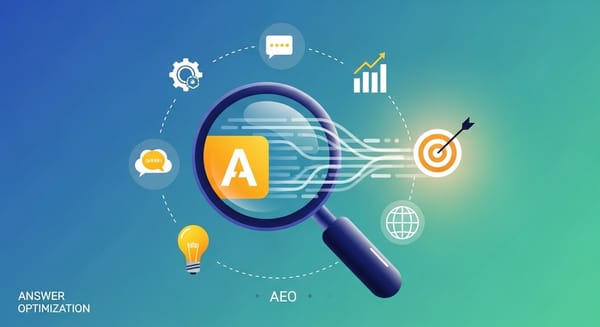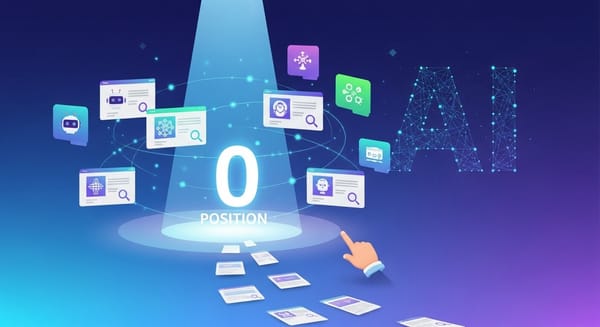Large Language Model Optimization for E-commerce | How to Rank Products in AI Shopping

The rise of large language models (LLMs) like GPT, Claude, and Gemini has revolutionized product discovery. It enables AI shopping assistants to generate product recommendations, summarize product comparisons, and assist shoppers with complex purchase decisions.
For e-commerce specifically, optimizing product data for LLMs addresses challenges like ensuring real-time product accuracy (pricing, availability), handling large product catalogs at scale, and making product information semantically understandable across multimodal shopping queries (text, voice, image).
These optimizations enhance LLMs' ability to recommend your products effectively. This article explores key LLM optimization techniques for e-commerce, product content strategies, and practical tools to achieve high AI shopping ranking for your products.
Understanding LLMs for E-commerce Product Discovery
Before diving into optimization, it's important to understand how LLMs process and recommend products:
How AI Shopping Assistants Work:
- Product Data Ingestion: LLMs consume product information from various sources (your store, reviews, specifications, comparisons)
- Semantic Understanding: AI interprets shopping queries like "best wireless headphones for travel under $200"
- Product Matching: LLMs match product attributes, use cases, and features to shopper needs
- Recommendation Generation: AI synthesizes product recommendations with reasoning
- Continuous Learning: LLMs update product knowledge from new data sources
The E-commerce Challenge:
Unlike general content, product data has unique requirements:
- Real-time accuracy (pricing, stock status)
- Structured specifications (technical details, dimensions, materials)
- Shopping context (use cases, "best for" scenarios)
- Comparison readiness (how products stack up against alternatives)
- Trust signals (reviews, ratings, sales data)
Optimizing for these requirements ensures your products get recommended effectively.
Core LLM Optimization Techniques for E-commerce Product Data
1. Overcoming Online Model Limitations with Strategic Hosting
Externally hosted LLM APIs often face cost and latency issues due to pay-as-you-go pricing and network overhead. Hosting models internally or using specialized pipelines reduces API dependency, improving latency and enabling real-time content processing. Smaller, domain-specific models can be tailored to content needs, offering cost-effective and precise performance.
2. Model Selection and Fine-Tuning: Customizing AI for Your Content
Choosing the right LLM is critical. Smaller, domain-specific models (e.g., BERT-based architectures) often match the performance of larger models for specialized tasks while using fewer resources.
- Fine-Tuning: Training a pre-trained model on a domain-specific dataset optimizes its parameters for specific tasks, improving accuracy and reducing computational overhead. This enables LLMs to better understand domain-specific jargon, terminology, and context, enhancing content referencing and response quality.
- Parameter-Efficient Fine-Tuning (PEFT): Techniques like LoRA (Low-Rank Adaptation) use rank decomposition to integrate small trainable submodules, reducing trainable parameters while maintaining performance. QLoRA further optimizes by quantizing weights to 4-bit precision, minimizing memory usage.
- Prompt Tuning: Methods like FedPepTAO reduce parameters to update, improving efficiency in federated learning scenarios and enhancing LLM performance on specific content.
- Data Preparation: Effective data preparation is key to AI search ranking. Using "queries as instructions" trains LLMs to answer document-related questions. For code, the "summary method" splits code functionally and generates summaries, improving domain-specific code understanding. Keywords or headings as instructions guide LLMs to process content accurately.
3. Knowledge Distillation: Efficient Knowledge Transfer
Knowledge distillation transfers expertise from a larger "teacher" model to a smaller "student" model, retaining much of the original’s knowledge while improving inference speed and reducing memory needs.
- Enhanced Understanding: Student models learn rationales and reasoning processes, improving logical response generation. Structured content is more effectively learned and reproduced.
- Context Distillation: Stripping engineered prompts to use final answers for fine-tuning increases correct response rates, making content more "rankable."
- Trade-offs: Distillation may reduce accuracy, inheriting teacher model biases or hallucinations, requiring a balance between speed, memory, and quality.
4. Quantization: Enhancing Deployability
Quantization reduces model weight and activation precision (e.g., from 32-bit to 8-bit or 4-bit integers), lowering memory usage and computational load.
- Impact on Content Processing: Quantization enables deployment on smaller GPUs or edge devices, making powerful LLMs more accessible for complex content processing without significant accuracy loss.
- Benefits: Offers 50% memory savings for 8-bit and 75% for 4-bit quantization, with 2x-3x inference speed improvements.
- Approaches: Post-Training Quantization (PTQ) is fast, using pre-quantized checkpoints. Quantization-Aware Training (QAT) applies quantization during training to mitigate quality degradation but requires more resources.
Advanced Product Optimization for LLM Inference
These techniques ensure LLMs process your product data quickly and accurately when generating shopping recommendations:
1. Product Catalog Caching for Consistent Recommendations
Similar to KV Caching in LLM inference, ensure your product information is consistently structured across your catalog so LLMs can "cache" understanding of your product format.
E-commerce Application:
If every product follows the same structure:
markdown
## [Product Name]
**Quick Summary:** [40-60 word product essence]
**Best For:** [Target customer profile]
**Key Specs:** [Structured specifications]
**Price:** [Current pricing]
**Rating:** [Customer reviews]
**Comparison:** [Vs. alternatives]...then LLMs learn your product format and extract information more efficiently across your entire catalog.
Benefit: Consistent product formatting means AI platforms process your products faster and more accurately, increasing recommendation likelihood.
2. Continuous Product Batching: Real-Time Updates
Just as continuous batching groups LLM requests, ensure your product data updates are continuously synchronized to AI platforms in batches.
E-commerce Application:
Critical Product Changes That Need Real-Time Batching:
- Price updates (sales, discounts)
- Stock availability changes
- New product reviews and ratings
- Seasonal product relevance shifts
Manual Approach (Slow): Update products individually, AI platforms see stale data for days/weeks.
Ecommerce AEO Tool: Use Answee to optimized your products pages for AI platforms in real-time, ensuring ChatGPT, Perplexity, and Google AI always have current product information.
Why This Matters:
LLMs deprioritize products with outdated information. A product showing "out of stock" or wrong pricing won't get recommended, even if it's now available.
3. Speculative Product Recommendation: Anticipating Shopping Queries
The Concept: Similar to speculative decoding, anticipate which shopping queries your products should rank for and pre-optimize product content for those queries.
E-commerce Application:
Step 1: Identify Target Shopping Queries
- "Best wireless headphones for travel"
- "Noise-cancelling headphones under $200"
- "Long battery headphones for flights"
Step 2: Embed Answers in Product Content
Directly answer these queries within your product descriptions:
markdown
## For Travelers: Why This Product is Best
Frequent flyers consistently rate the SoundMax Pro as the best travel companion because:
- 30-hour battery outlasts any international flight
- Active noise cancellation blocks engine noise completely
- Foldable design fits easily in carry-on bags
- Quick charge delivers 2 hours of use in 10 minutes
This makes them ideal for business travelers, vacation flyers, and anyone who wants reliable audio on long trips.When someone asks ChatGPT "best wireless headphones for travel," your product content directly answers this query, increasing recommendation probability.
Tools for LLM Optimization Implementation
Implementing these optimization strategies requires specialized tools and platforms tailored to specific use cases. Below is a refined list of resources to support LLM optimization and content ranking:
E-Commerce and AI Answer Engine Optimization
- Answee: A platform designed to optimize e-commerce product content for AI answer engines (e.g., ChatGPT, Claude, Gemini). It automates product data optimization, tracks multi-platform visibility, and ensures structured data for AI discoverability.
- Structured Data Tools: Schema.org markup generators to create AI-readable product information, enhancing retrieval in RAG systems.
- Content Management Platforms: Headless CMS solutions (e.g., Contentful, Strapi) optimized for AI consumption, enabling structured, machine-readable content delivery.
Model Development and Fine-Tuning
- Hugging Face Transformers: A versatile library for training, fine-tuning, and deploying LLMs, supporting models like BERT and LLaMA.
- LoRA and QLoRA: Microsoft’s LoRA repository and QLoRA extensions for parameter-efficient fine-tuning, minimizing resource demands while adapting models to domain-specific tasks.
- OpenAI Fine-Tuning API: Simplifies customization of GPT models for specific use cases, ideal for businesses with proprietary datasets.
Knowledge Management and RAG
- LangChain: A framework for building LLM applications with RAG, integrating retrieval and generation for context-aware responses.
- Pinecone/Weaviate: Vector databases for semantic search, enabling efficient content retrieval in RAG pipelines.
- Elasticsearch: Combines traditional search with vector capabilities, supporting hybrid search for AI applications.
- Haystack: An end-to-end NLP framework with retrieval components, streamlining RAG implementation for content ranking.
Monitoring and Analytics
- LangSmith: Monitors and debugs LLM applications, ensuring performance and reliability in production.
- Weights & Biases: Tracks model performance and fine-tuning metrics, providing insights for optimization.
- MLflow: Manages the ML lifecycle, including model training, deployment, and monitoring.
- Custom Analytics Platforms: Tools like Answee’s analytics track AI answer engine performance, measuring content visibility and effectiveness.
Strategies for Product Ranking in AI Shopping: Optimizing for LLM Understanding
Ranking products in AI shopping involves making product data discoverable, understandable, and recommendable for LLMs, particularly through Retrieval Augmented Generation (RAG) and optimized product content.
1. Retrieval Augmented Generation (RAG) for Product Discovery
How RAG Works for Products:
When a shopper asks ChatGPT "What are the best wireless headphones for travel under $200?", the LLM:
- Retrieves product information from various sources using embeddings and vector similarity search
- Augments its knowledge with current product data (pricing, reviews, specs)
- Generates consolidated product recommendations based on retrieved information
To Rank Effectively in Product RAG:
Product Content Retrievability:
- Structure product pages for easy indexing
- Use semantic product chunking (separate sections for specs, use cases, comparisons)
- Ensure product data is discoverable by retrieval systems
Product Content Relevance:
- Clear, domain-specific product language ("noise-cancelling headphones" not "audio isolation devices")
- Shopping-intent optimization ("best for travelers" not "suitable for various users")
- Product comparison context within descriptions
Product Data Preparation:
"Queries as Instructions" for Products:
markdown
Q: What are the best wireless headphones under $200?
A: The SoundMax Pro ($149) offers professional-grade noise cancellation and 30-hour battery life, matching the performance of $400 headphones at a fraction of the cost.
Q: Which headphones have the longest battery life for travel?
A: SoundMax Pro leads with 30 hours continuous playback, outlasting any international flight without recharging.This format trains LLMs to recommend your products when answering shopping queries.
2. Enhancing Product Understandability via Content Optimization
Domain-Specific Product Language:
Use terminology shoppers and LLMs both understand:
✅ LLM-Friendly:
- "Wireless noise-cancelling headphones"
- "30-hour battery life"
- "Best for travel and commuting"
- "Under $200 price range"
❌ LLM-Confusing:
- "Premium audio solution"
- "Extended operational duration"
- "Suitable for various scenarios"
- "Competitive pricing"
Structured Product Information:
Logical product content structures enable LLMs to extract and recommend effectively:
markdown
## Product Overview
[40-60 word product essence]
## Key Specifications
[Structured technical details]
## Best For (Use Cases)
- Frequent travelers: [Why this product]
- Remote workers: [Why this product]
- Daily commuters: [Why this product]
## Comparison vs. Alternatives
[How this stacks up]
## Customer Reviews
[Social proof and trust signals]Reducing Product Hallucinations:
LLMs sometimes "hallucinate" incorrect product information. Prevent this by:
Provide Clear, Accurate Product Facts:
- Exact specifications (not ranges or approximations)
- Current pricing (updated regularly)
- Real availability status
- Verified customer review counts
Use Semantic Product Chunking: Break long product descriptions into clear sections so LLMs don't confuse product attributes:
markdown
### Battery Specifications
- Continuous playback: 30 hours
- Standby time: 45 days
- Charge time: 2 hours (full charge)
- Quick charge: 10 minutes = 2 hours playback
### Connectivity Specifications
- Bluetooth version: 5.2
- Range: 50 feet line-of-sight
- Multi-device: Connect to 2 devices simultaneously
- Codecs supported: SBC, AAC, aptXClear section boundaries prevent LLMs from mixing battery specs with connectivity specs.
Understanding how LLMs work for product understanding is crucial for modern e-commerce optimization. These AI models analyze product data semantically, which has given rise to new strategies like Answer Engine Optimization for products and Generative Engine Optimization for e-commerce.
Unlike traditional product SEO approaches—where SEO targets product page rankings—successful online retailers now need both strategies to dominate product visibility across traditional search and AI-powered shopping platforms.
Practical Guidelines for Product Content Optimization
To ensure product data is effectively processed and recommended by LLMs:
1. Use High-Quality, Structured Product Data
Product Data Recipe: "Queries as Instructions"
Structure product content to directly answer common shopping questions:
markdown
## SoundMax Pro Wireless Headphones
**Shopping Query: "Best wireless headphones for travel?"**
Answer embedded in product description:
"The SoundMax Pro ranks as the best travel headphones under $200 because..."
**Shopping Query: "Which headphones have longest battery?"**
Answer embedded in specifications:
"30-hour continuous battery life - longest in price range..."
**Shopping Query: "Comfortable headphones for long flights?"**
Answer embedded in comfort section:
"Memory foam ear cups and 8.5 oz lightweight design enable comfortable 10+ hour wear..."2. Select Appropriate Product Content Formats
For Product Catalogs:
- Use smaller, product-specific content blocks vs. long-form descriptions
- Implement PEFT-like optimization: focus on essential product attributes
- For small product lines, detailed optimization works; for large catalogs (1000+ products), focus on scalable structured formats
3. Apply Knowledge Distillation to Product Information
Distill Complex Products into Clear Summaries:
Complex Product (Full Details): [Comprehensive 2000-word product description with every feature, specification, use case, and comparison]
Distilled Product (LLM Optimized): [40-60 word essence + structured specifications + use case bullets + comparison context]
LLMs extract and recommend from the distilled version more effectively.
4. Implement Product Data "Quantization"
Reduce Product Information to Essential Precision:
Focus on the 20% of product attributes that drive 80% of shopping decisions:
High-Priority Product Attributes (Include):
- Product name and category
- Price and availability
- Top 5 key specifications
- Primary use case
- Customer rating and review count
- Comparison to #1 competitor
Lower-Priority Product Attributes (Optional):
- Detailed manufacturing process
- Comprehensive feature lists
- Peripheral specifications
- Lengthy marketing copy
5. Optimize Product Inference Speed
For Real-Time Product Recommendations:
Structure Products for Fast LLM Extraction:
- Place essential product data at the top (first 200 words)
- Use consistent product formatting across catalog
- Implement structured product schema
- Cache product information with real-time updates
Batch Product Updates Efficiently:
- Group price changes for batch submission
- Synchronize inventory updates across platforms
- Update product reviews in regular intervals
6. Structure Product Content Clearly for LLM Consumption
Use Semantic Product Chunking:
Break product content into clear, logical sections:
markdown
## Product Overview
[Product essence and "best for" statement]
## Technical Specifications
[Structured specs table]
## Use Case Scenarios
[When/why to use this product]
## Comparison Context
[How this compares to alternatives]
## Customer Feedback
[Reviews and social proof]
## Purchase Details
[Pricing, shipping, warranty, returns]Each section can stand alone, allowing LLMs to extract specific information without processing entire product pages.
For Code-Heavy Products (Electronics):
Use the "summary method" for technical products:
- Split product functionality into sections
- Generate summaries for each technical feature
- Improves LLM understanding of complex technical products
Frequently Asked Questions Frequently Asked Questions about LLM Optimization
1. What is LLM optimization for e-commerce?
LLM optimization for e-commerce enhances how effectively AI shopping assistants like ChatGPT, Perplexity, and Google AI understand, process, and recommend your products. It involves structuring product data, optimizing product content, and ensuring real-time product accuracy so LLMs can generate accurate product recommendations to shoppers.
2. Why is LLM optimization important for online retailers?
Optimization enables AI shopping platforms to recommend your products more frequently and accurately, critical for capturing shoppers who use ChatGPT and AI assistants for product research. Without optimization, your products remain invisible to the 67% of shoppers now using AI for purchase decisions.
3. What are the key LLM optimization techniques for products?
- Product Schema Structuring: Using structured data (JSON-LD) for LLM understanding
- Product Content Optimization: Clear, semantic product descriptions with use cases
- Knowledge Distillation: Reducing product info to essential, LLM-friendly formats
- Real-Time Product Updates: Continuous synchronization of pricing and availability
- Shopping Query Alignment: Embedding answers to shopping questions in product content
4. How does product data "quantization" help AI recommendations?
Product data quantization means reducing product information to its most essential attributes that LLMs need for recommendations. By focusing on critical specs (price, key features, use case, ratings) and minimizing marketing fluff, LLMs can process products more efficiently and recommend them more accurately.
5. What is product content "distillation" and why does it matter?
Product content distillation transfers complex product information into concise, LLM-friendly formats (40-60 word summaries + structured specs) that retain all critical details. LLMs process distilled product content faster and extract information more accurately, increasing recommendation likelihood.
6. How do online retailers implement RAG for products?
Retrieval Augmented Generation (RAG) for products involves structuring product data so AI systems can retrieve and recommend your products when generating shopping responses. Implementation requires: (1) Product schema markup, (2) Semantic product chunking, (3) Shopping query-aligned content, (4) Real-time product data accuracy.
7. Can small online stores compete with major retailers in LLM optimization?
Yes! LLM optimization prioritizes product data quality and structure over brand size. Small stores with well-optimized product information often outperform major retailers in AI recommendations for specific product niches—especially when using tools like Answee to optimize at scale.
8. How does Answee help with LLM optimization for e-commerce?
Answee automates LLM optimization for product catalogs with: (1) Automated product schema generation, (2) Real-time product data synchronization to AI platforms, (3) Shopping query mapping, (4) Product visibility tracking across ChatGPT/Perplexity/Google AI, (5) Bulk catalog optimization, (6) Shopify/WooCommerce native integration. This scales LLM optimization from 50-100 products (manual maximum) to 5,000+ products efficiently.




